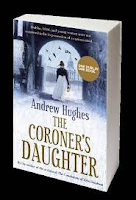This year’s One Dublin, One Book, The Coroner’s Daughter, is historical fiction and a crime novel, set in the Dublin of 1816. Moreover, it is medical historical fiction, and imagined around an RCSI anatomist. So, with this book in our minds, let’s take a glimpse at the archives with RCSI Heritage Collections.
In the year 1816, RCSI had been operating under its First Charter, which was granted to the College by George III in 1784. The surgeons had formally broken the historical ties with the Guild of Barber-Surgeons- a goal the College founders had set out to achieve when they met and formed the Dublin Society of Surgeons in 1783. RCSI was established to set and support professional standards for surgical training and practice.
 |
| RCSI Royal Charter, 1784 |
 |
| Rules of the Dublin Society of Surgeons, 1783 |
The backdrop of ‘the College of Surgeons’ in 1816 would have been the first iteration of the building erected on a disused Quaker burial ground, on St. Stephen’s Green and the corner of York Street. Built in 1810, it was known as ‘Surgeon’s Hall’.
 |
| Royal College of Surgeons in Ireland, 1810 |
The Napoleonic Wars of 1803–1815 had been a factor in the desire
for quality, formal training in Europe, Britain and Ireland. Dublin’s medical
education scene was taking off in this era and there were anatomy theatres and
dissection halls located in small medical schools and hospitals. RCSI’s
prominence in this context and its thriving student numbers meant the College
was quickly running out of space, and by 1825 expansion began on the Green,
resulting in the wider façade we recognise today.
 |
| Architectural drawing for the Front Door of the expanded 123 St. Stephen’s Green, 1825 |
 |
| Façade of RCSI, 1828 |
The current Department of Anatomy and Regenerative Medicine is the oldest department in RCSI and has been teaching anatomy, the structure of the human body, and biology in the College since 1785. In 1811, Abraham Colles published A Treatise on Surgical Anatomy, pioneering the clinical model that medical students the world over experience today.
The Anatomy Room was built in 1812 when Colles was Professor of Anatomy. Today, his example is still followed in teaching anatomy that is relevant to clinical practice. By 1816, Colles was still at the helm and student numbers had been steadily increasing at RCSI, and would continue to do so, thanks to its reputation and its advances in surgical teaching.
 |
| Abraham Colles’ Treatise of Surgical Anatomy, 1811 |
Abraham Colles was a leading figure in the golden age of Irish medicine in the 19th century and RCSI Heritage Collections has recently announced Heritage Council funding for digitisation of Colles archival material.
Meanwhile, in 1810, Kirby’s "The Theatre of Anatomy and School of Surgery" opened on nearby Stephen Street, and many other schools would open, close and amalgamate throughout the nineteenth century.
Many well-known anatomists and surgeons, including Kirby (Demonstrator in Anatomy 1809-1811; President 1834), took up positions with RCSI. Kirby remains legendary for his dramatic lectures, where he would shoot cadavers to simulate battle wounds for his students to work on.
 |
| Bust of John Kirby, RCSI |
(More on that in a previous blog post https://rcsiheritage.blogspot.com/2014/08/i-shoot-dead-people.html).
 |
| RCSI Museum, c. 1800s |
 | |
| Descriptive Catalogue of the Preparations in the Museum, of the Royal College of Surgeons in Ireland, 1834 |
Along with a Museum, there was of course the Library, and
1816 is the year it acquired a large collection from the defunct
Physico-Chirurgical Society, according to RCSI’s Charles Alexander Cameron, in
the History of the Royal College of
Surgeons in Ireland (1886).
In 1816, The Anatomy Act of 1832 was still many years off, and Cameron gives several pages of his History to the subject of dissections and body snatching in the past, the conveyance of bodies of convicts to the College, up to the "Resurrection Riots” stemming from the infamous Burke and Hare crimes. “Many (Dubliners) would not venture out of their homes after nightfall… They feared that some local Burke might pounce upon them, murder them, and dispose of their bodies to the surgeons”. Cameron comments on the positions of those associated with the College throughout the era of ‘sack-them-up men’ as well as the measures taken to ‘stop these abuses’, in the lead up to the 1832 Act that “extinguished the resurrection men’s occupation”. An end of an era!


.png)